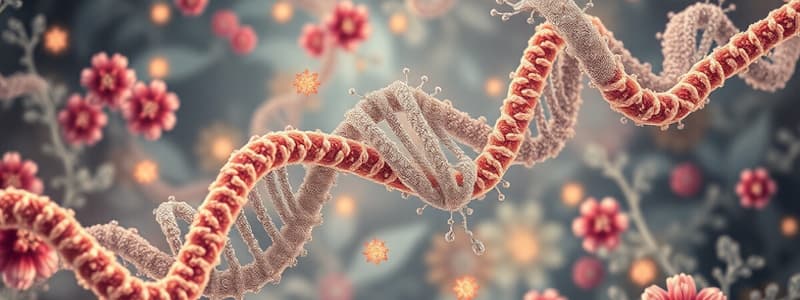Podcast
Questions and Answers
What is the central dogma of molecular biology?
What is the central dogma of molecular biology?
- DNA >>> protein >>> RNA
- DNA >>> RNA >>> protein (correct)
- Protein >>> RNA >>> DNA
- RNA >>> DNA >>> protein
Which structure of DNA is described as the double-stranded helix?
Which structure of DNA is described as the double-stranded helix?
- Quaternary structure
- Secondary structure (correct)
- Tertiary structure
- Primary structure
What type of sugar is found in the structure of DNA?
What type of sugar is found in the structure of DNA?
- Ribose
- Glucose
- Deoxyribose (correct)
- Fructose
Which of the following components is NOT part of a nucleotide?
Which of the following components is NOT part of a nucleotide?
What is the primary structure of DNA primarily determined by?
What is the primary structure of DNA primarily determined by?
What are the purine bases found in nucleic acids?
What are the purine bases found in nucleic acids?
What type of bond links nucleotides in a DNA strand?
What type of bond links nucleotides in a DNA strand?
What is the significance of the 5’ and 3’ ends of a nucleic acid strand?
What is the significance of the 5’ and 3’ ends of a nucleic acid strand?
What stabilizes the double helix structure of DNA?
What stabilizes the double helix structure of DNA?
Which of the following bases is not found in DNA?
Which of the following bases is not found in DNA?
What does the term 'antiparallel' refer to in the context of the DNA double helix?
What does the term 'antiparallel' refer to in the context of the DNA double helix?
What type of interaction contributes to the stability of the nitrogenous base pairing in DNA?
What type of interaction contributes to the stability of the nitrogenous base pairing in DNA?
What distinguishes a pyrimidine from a purine in the context of nucleic acid bases?
What distinguishes a pyrimidine from a purine in the context of nucleic acid bases?
Flashcards are hidden until you start studying
Study Notes
Central Dogma of Molecular Biology
- Central dogma: DNA transcribes to RNA, which translates to protein.
- Fundamental principles of molecular biology explaining gene expression.
What is DNA?
- Deoxyribonucleic acid (DNA) is crucial for organism development and function.
- Acts as the primary unit of heredity across all organisms.
Structure of DNA
- Three hierarchical levels of structure:
- Primary: nucleotide sequence.
- Secondary: double-stranded helical structure.
- Tertiary: higher-order folding for DNA packaging.
Nucleotides
- Common structure: composed of sugar (deoxyribose), phosphate group, and nitrogenous base.
- Carbons in sugar are numbered, crucial for understanding nucleotide connectivity.
Nitrogenous Bases
- Two types of bases:
- Purines: Adenine (A) and Guanine (G).
- Pyrimidines: Cytosine (C), Thymine (T) in DNA, and Uracil (U) in RNA.
DNA Helix Structure
- Composed of two coiled strands forming a double helix.
- Sides are made of deoxyribose sugar linked to phosphate groups via phosphodiester bonds.
- Center consists of nitrogen bases joined by weak hydrogen bonds.
Nucleotide Chain Directionality
- Nucleotide sequences are represented from 5’ to 3’ direction.
- Phosphodiester bonds link the 5’ phosphate of one nucleotide to the 3’ hydroxyl of another.
Watson and Crick Model
- Watson and Crick developed the three-dimensional model of DNA structure.
- Native DNA formed by complementary antiparallel chains.
Stability of DNA Double Helix
- Stability achieved through:
- Hydrogen bonding between complementary base pairs (A-T and G-C).
- Hydrophobic interactions between stacked planar bases.
Visual Representation of DNA
- Rungs of the ladder represent nitrogenous bases.
- Legs of the ladder are formed from the sugar-phosphate backbone.
Studying That Suits You
Use AI to generate personalized quizzes and flashcards to suit your learning preferences.



